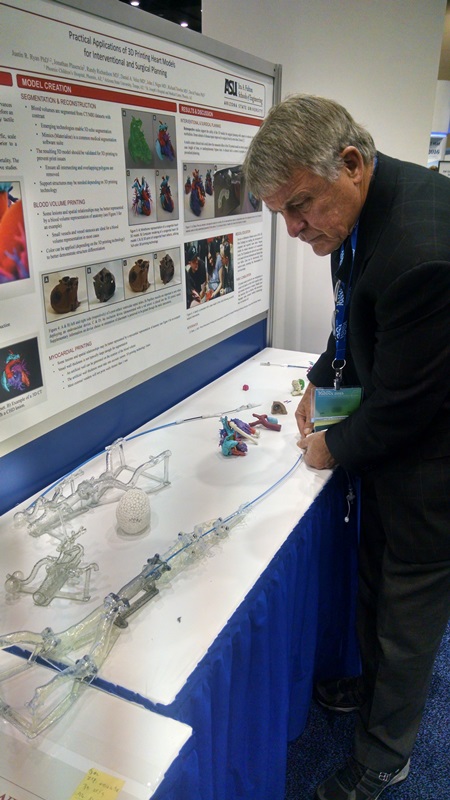Advanced 3D Printed IVC Filter and Arterial Vascular Training Models
The Most Advanced Vascular Training Models for Physicians
Embodi3D has created a line of super-accurate 3D printed vascular models for physician and medical professional advanced training. Created by a board-certified physician who performs vascular procedures daily, these models were created for maximum procedural realism while being more practical and less expensive than conventional animal labs or silicone tube models. Physician specialists who utilize these models include vascular surgeons, cardiologists, and radiologists. Numerous medical device companies use these models to teach and demonstrate their devices under realistic circumstances. Hospitals and medical schools use them to teach residents, fellows and medical students how to perform vascular procedures.
To view our full product catalog with updated information please see the Vascular Training Models page. You will learn about the models shown on this page and many more.
If you are interested in these training models, please Contact us.
IVC Filter - Whole Body Venous Training Model
The whole body venous medical training model includes all the major venous structures in the human body from the right jugular vein of the neck to the right and left common femoral veins at the level of the hips. The whole body venous model allows for the education and training in a variety of IVC filter related procedures. The model was created from a real CT scan so the vessel positions, diameters, and angles are all real. Entry points are present at the right jugular vein and brachiocephalic vein for upper body access, and the bilateral common femoral veins for lower body access. Attachments are present to make placement of a real vascular sheath easy.
The model can be used to teach or practice the following procedures:
- IVC filter placement, jugular or femoral approach
- Common iliac filter placement, jugular or femoral approach
- IVC filter retrieval
- Venous stenting
- IVC and iliac vein thrombectomy or thrombolysis
- Venous embolization
- Hepatic vein cannulation
The model can be used to illustrate specific devices for the procedures listed above and is used by medical device companies to demonstrate and teach the use of their products. The IVC model comes in a portable carrying case and is easily transportable. It assembles and disassembles in less than 20 seconds.
Caption: An attendee of the Radiological Society of North America (RSNA) meeting deploying an IVC filter in the IVC filter training model. Models are commonly used at medical trade shows to allow attendees to quickly get hands-on experience with medical equipment.
If you are interested in the IVC Filter - whole body venous training model, please contact us.
Abdomen and Pelvis Arterial Embolization and Stenting Medical Model
The abdomen and pelvis embolization and stenting model has detailed arterial anatomy generated from a real CT scan, so the exact vessel shapes, diameters, and angles are all real. Numerous detailed vessel branches are included for maximum realism and for practicing extremely fine catheterization. For example, the right, middle, and left hepatic arteries are included, which are only accessible after four levels of branching (Aorta -> Celiac artery -> Common hepatic artery -> Proper hepatic artery -> Right, middle, and left hepatic arteries). Vascular sheath attachment points are present at the right and left common femoral arteries, as they would be during a real procedure. This provides an unparalleled level of realism for training in an in vitro model. It is a revolutionary training tool for interventional radiologists, cardiologists, and vascular surgeons. It is commonly used at professional training sessions, trade shows and conventions, in-hospital training sessions, and at medical schools for teaching residents and fellows. Medical device companies use the model to demonstrate and teach the use of their microcatheter, wire, and embolization products to physicians.
This medical model can be used to teach or practice the following procedures:
- Aneurysm embolization
- Stent assisted embolization
- Balloon assisted embolization
- Splenic artery embolization
- Gastroduodenal artery embolization
- Yttrium-90 radioembolization mapping
- Yttrium-90 radioembolization treatment
- Hepatic chemoembolization
- Angiography for G.I. bleeding
- Renal artery angiography
- Renal artery stenting
- Pelvic angiography and embolization for trauma
- Internal iliac artery embolization
- Internal iliac artery stent-grafting
- Abdominal aorta stent-grafting
Arteries Included:
- Abdominal aorta
- Common iliac arteries
- Internal and external iliac arteries
- Common femoral arteries
- Celiac artery and branches
- Splenic artery
- Left gastric artery
- Common hepatic artery, left, middle, and right hepatic arteries
- Gastroduodenal artery
- Superior mesenteric artery and branches
- Inferior mesenteric artery and branches
- Renal arteries
Aneurysms included:
- Splenic artery, proximal, 25 mm berry aneurysm, 10 mm neck
- Splenic artery, distal, 20 mm berry aneurysm, 7.5 mm neck
- Right renal, 10 mm berry aneurysm, 8 mm neck
- Left renal, inferior, 5 mm berry aneurysm, 3.5 mm neck
- Left iliac artery, fusiform aneurysm, 33 mm x 23 mm
Arterial Stenoses:
- Left renal, accessory branch, stenosis, 2mm
The model assembles and disassembles in less than 20 seconds. It comes with its own durable and customized carrying case for safe and easy transport
Thank you for your interest in Embodi3D's advanced vascular training models. If you have any additional questions about our existing training models, or are interested in having us create a new training model for your special need, please contact us.







0 Comments
Recommended Comments
There are no comments to display.
Create an account or sign in to comment
You need to be a member in order to leave a comment
Create an account
Sign up for a new account in our community. It's easy!
Register a new accountSign in
Already have an account? Sign in here.
Sign In Now